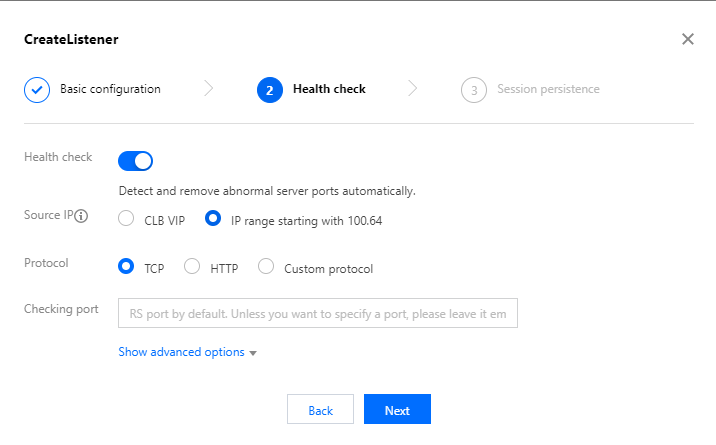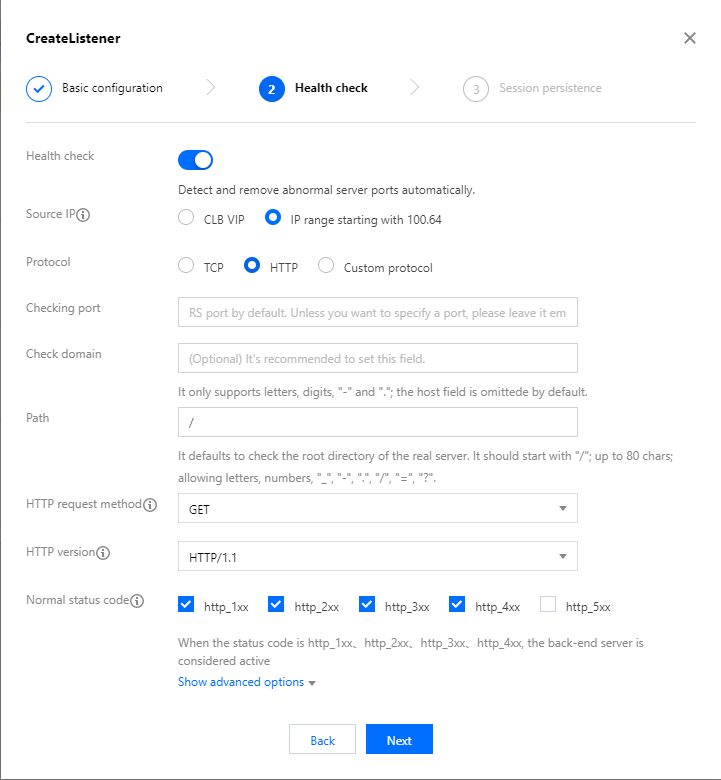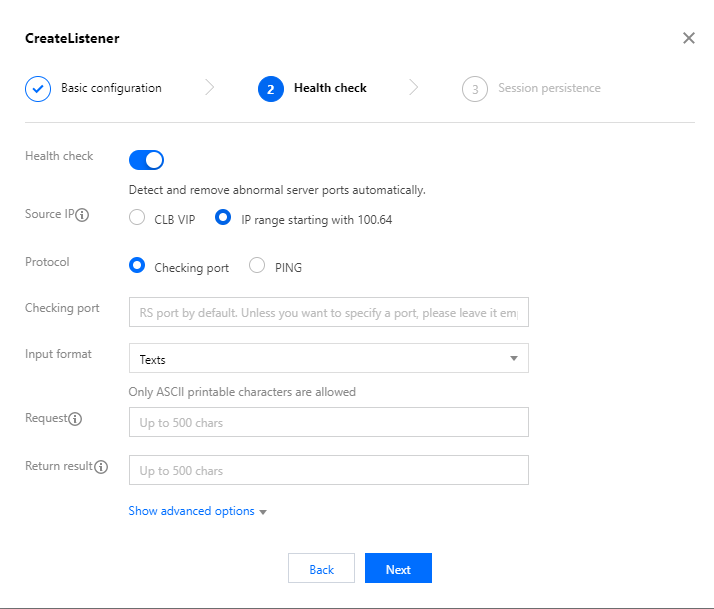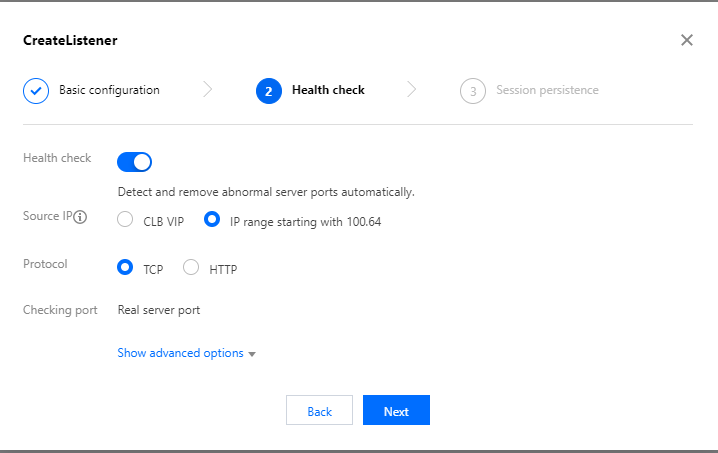配置健康检查
最后更新时间:2024-01-04 17:32:00
限制说明
IPv6 版本的负载均衡的 TCP 监听器不支持 HTTP 健康检查和自定义方式健康检查。
IPv6 版本的负载均衡的 UDP 监听器不支持自定义方式的健康检查。
前提条件
1. 您已创建负载均衡实例,详情请参见 创建负载均衡实例。
2. 您已创建负载均衡监听器。
创建 TCP 监听器,详情请参见 配置 TCP 监听器。
创建 UDP 监听器,详情请参见 配置 UDP 监听器。
创建 TCP SSL 监听器,详情请参见 配置 TCP SSL 监听器。
创建 HTTP 监听器,详情请参见 配置 HTTP 监听器。
创建 HTTPS 监听器,详情请参见 配置 HTTPS 监听器。
TCP 监听器
四层 TCP 监听器支持四层 TCP、七层 HTTP 和自定义方式三种类型的健康检查。
TCP 健康检查通过 SYN 包即发起 TCP 三次握手来获取后端服务器的状态信息。
HTTP 健康检查通过发送 HTTP 请求来获取后端服务器的状态信息。
自定义健康检查通过自定义应用层协议的输入和输出内容来获取后端服务器的状态信息。
配置 TCP 健康检查
1. 参考 前提条件,操作至“健康检查”页签。
2. 在“健康检查”页签,选择“TCP”检查方式。


参数 | 说明 |
健康检查 | 可开启或关闭健康检查功能。建议您开启健康检查,帮助您自动检查并移除异常的后端服务器端口。 |
健康探测源 IP | 健康检查探测包的源 IP,默认为100.64.0.0/10网段,使用该网段可以有效避免地址冲突。存量用户可选负载均衡的 VIP 作为健康探测的源 IP,也可通过自助工具一键切换为100.64.0.0/10网段,详情请参见 健康探测源 IP 诊断助手。 |
检查方式 | 选择“TCP”表示配置 TCP 健康检查。 |
检查端口 | 非必填,不填写端口时默认为后端服务器端口。除需要指定特定端口以外,其余情况建议不填写。 |
显示高级选项 |
配置 HTTP 健康检查
1. 参考 前提条件,操作至“健康检查”页签。
2. 在“健康检查”页签,选择“HTTP”检查方式。


参数 | 说明 |
健康检查 | 可开启或关闭健康检查功能。建议您开启健康检查,帮助您自动检查并移除异常的后端服务器端口。 |
健康探测源 IP | 健康检查探测包的源 IP,默认为100.64.0.0/10网段,使用该网段可以有效避免地址冲突。存量用户可选负载均衡的 VIP 作为健康探测的源 IP,也可通过自助工具一键切换为100.64.0.0/10网段,详情请参见 健康探测源 IP 诊断助手。 |
检查方式 | 选择“HTTP”表示配置 HTTP 健康检查。 |
检查端口 | 非必填,不填写端口时默认为后端服务器端口。除需要指定特定端口以外,其余情况建议不填写。 |
检查域名 | 健康检查域名: 长度限制:1 - 80个字符。 默认为转发域名。 不支持正则表达式,当您的转发域名为通配域名时,需要指定某一固定域名(非正则)为健康检查域名。 支持的字符集为:a-z 0-9 . -。 |
检查路径 | 健康检查路径 : 长度限制:1 - 200个字符。 默认为 /,且必须以 / 开头。 不支持正则表达,建议指定某个固定 URL 路径(静态页面)进行健康检查。 支持的字符集为:a-z A-Z 0-9 . - _ / = ?。 |
HTTP 请求方式 | 健康检查的 HTTP 请求方式,可选:GET 或 HEAD,默认为 GET。 若使用 HEAD 方法,服务器仅返回 HTTP 头部信息,可降低后端开销,提升请求效率,对应的后端服务需支持 HEAD。 若使用 GET 方法,则后端服务支持 GET 即可。 |
HTTP 版本 | 后端服务的 HTTP 版本。 若后端服务器支持的 HTTP 版本为1.0,则无需校验请求的 Host 字段,即无需配置检查域名。 若后端服务器支持的 HTTP 版本为1.1,则需要校验请求的 Host 字段,即需要配置检查域名。 说明:当选择 HTTP /1.1 版本时,此时若未配置检查域名,按照 HTTP 标准协议,后端服务器会返回400错误码,提示健康检查异常,建议勾选正常状态码http_4xx。 |
正常状态码 | 当状态码为所选状态码时,认为后端服务器存活,即健康检查正常。可选:http_1xx、http_2xx、http_3xx、http_4xx 和 http_5xx。 |
显示高级选项 |
配置自定义健康检查
1. 参考 前提条件,操作至“健康检查”页签。
2. 在“健康检查”页签,选择“自定义”检查方式。


参数 | 说明 |
健康检查 | 可开启或关闭健康检查功能。建议您开启健康检查,帮助您自动检查并移除异常的后端服务器端口。 |
健康探测源 IP | 健康检查探测包的源 IP,默认为100.64.0.0/10网段,使用该网段可以有效避免地址冲突。存量用户可选负载均衡的 VIP 作为健康探测的源 IP,也可通过自助工具一键切换为100.64.0.0/10网段,详情请参见 健康探测源 IP 诊断助手。 |
检查方式 | 选择“自定义”表示配置自定义协议健康检查。 |
检查端口 | 非必填,不填写端口时默认为后端服务器端口。除需要指定特定端口以外,其余情况建议不填写。 |
输入格式 | 支持文本和十六进制输入。 输入格式为文本是将文本转换成二进制进行请求发送和返回结果对比。 输入格式为十六进制是将十六进制转换成二进制进行请求发送和返回结果对比。 |
检查请求 | 自定义健康检查请求内容,必填。例如探测 DNS 服务的检查请求示例为:F13E0100000100000000000003777777047465737403636F6D0774656E63656E7403636F6D0000010001。 |
检查返回结果 | 自定义健康检查请求时,必须填写健康检查返回结果。例如探测 DNS 服务的检查返回结果示例为:F13E。 |
显示高级选项 |
UDP 监听器
UDP 监听器支持 UDP 健康检查,包括检查端口和 PING 两种检查类型。
配置自定义健康检查
1. 参考 前提条件,操作至“健康检查”页签。
2. 在“健康检查”页签,选择“自定义”检查方式。


参数 | 说明 |
健康检查 | 可开启或关闭健康检查功能。建议您开启健康检查,帮助您自动检查并移除异常的后端服务器端口。 |
健康探测源 IP | 健康检查探测包的源 IP,默认为100.64.0.0/10网段,使用该网段可以有效避免地址冲突。存量用户可选负载均衡的 VIP 作为健康探测的源 IP,也可通过自助工具一键切换为100.64.0.0/10网段,详情请参见 健康探测源 IP 诊断助手。 |
检查方式 | 选择“自定义”表示健康探测源 IP 向后端服务器发送 UDP 探测报文来获取后端服务器的状态信息。 |
检查端口 | 非必填,不填写端口时默认为后端服务器端口。除需要指定特定端口以外,其余情况建议不填写。 |
输入格式 | 支持文本和十六进制输入。 输入格式为文本是将文本转换成二进制进行请求发送和返回结果对比。 输入格式为十六进制是将十六进制转换成二进制进行请求发送和返回结果对比。 |
检查请求 | 自定义健康检查请求内容。例如探测 DNS 服务的检查请求示例为:F13E0100000100000000000003777777047465737403636F6D0774656E63656E7403636F6D0000010001。 |
检查返回结果 | 自定义健康检查请求时,必须配置健康检查返回结果。例如探测 DNS 服务的检查返回结果示例为:F13E。 |
显示高级选项 |
配置 PING 健康检查
1. 参考 前提条件,操作至“健康检查”页签。
2. 在“健康检查”页签,选择“PING”检查方式。


参数 | 说明 |
健康检查 | 可开启或关闭健康检查功能。建议您开启健康检查,帮助您自动检查并移除异常的后端服务器端口。 |
健康探测源 IP | 健康检查探测包的源 IP,默认为100.64.0.0/10网段,使用该网段可以有效避免地址冲突。存量用户可选负载均衡的 VIP 作为健康探测的源 IP,也可通过自助工具一键切换为100.64.0.0/10网段,详情请参见 健康探测源 IP 诊断助手。 |
检查方式 | 选择“PING”表示通过 Ping 后端服务器的 IP 地址来获取后端服务器的状态信息。 |
显示高级选项 |
TCP SSL 监听器
配置 TCP 健康检查
1. 参考 前提条件,操作至“健康检查”页签。
2. 在“健康检查”页签,选择“TCP”检查方式。


参数 | 说明 |
健康检查 | 可开启或关闭健康检查功能。建议您开启健康检查,帮助您自动检查并移除异常的后端服务器端口。 |
健康探测源 IP | 健康检查探测包的源 IP,默认为100.64.0.0/10网段,使用该网段可以有效避免地址冲突。存量用户可选负载均衡的 VIP 作为健康探测的源 IP,也可通过自助工具一键切换为100.64.0.0/10网段,详情请参见 健康探测源 IP 诊断助手。 |
检查方式 | 选择“TCP”表示配置 TCP 健康检查。 |
检查端口 | TCP SSL 监听器的健康检查端口与监听端口一致。 |
显示高级选项 |
配置 HTTP 健康检查
1. 参考 前提条件,操作至“健康检查”页签。
2. 在“健康检查”页签,选择“HTTP”检查方式。


参数 | 说明 |
健康检查 | 可开启或关闭健康检查功能。建议您开启健康检查,帮助您自动检查并移除异常的后端服务器端口。 |
健康探测源 IP | 健康检查探测包的源 IP,默认为100.64.0.0/10网段,使用该网段可以有效避免地址冲突。存量用户可选负载均衡的 VIP 作为健康探测的源 IP,也可通过自助工具一键切换为100.64.0.0/10网段,详情请参见 健康探测源 IP 诊断助手。 |
检查方式 | 选择“HTTP”表示配置 HTTP 健康检查。 |
检查端口 | TCP SSL 监听器的健康检查端口与监听端口一致。 |
检查域名 | 健康检查域名: 长度限制:1 - 80个字符。 默认为转发域名。 不支持正则表达式,当您的转发域名为通配域名时,需要指定某一固定域名(非正则)为健康检查域名。 支持的字符集为:a-z 0-9 . -。 |
检查路径 | 健康检查路径 : 长度限制:1 - 200个字符。 默认为 /,且必须以 / 开头。 不支持正则表达,建议指定某个固定 URL 路径(静态页面)进行健康检查。 支持的字符集为:a-z A-Z 0-9 . - _ / = ?。 |
HTTP 请求方式 | 健康检查的 HTTP 请求方式,可选:GET 或 HEAD,默认为 GET。 若使用 HEAD 方法,服务器仅返回 HTTP 头部信息,可降低后端开销,提升请求效率,对应的后端服务需支持 HEAD。 若使用 GET 方法,则后端服务支持 GET 即可。 |
HTTP 版本 | 后端服务的 HTTP 版本,仅支持 HTTP1.1 版本。后端服务需要校验请求的 Host 字段,即需要配置检查域名。 说明:若未配置检查域名,按照 HTTP 标准协议,后端服务器会返回400错误码,提示健康检查异常,建议勾选正常状态码http_4xx。 |
正常状态码 | 当状态码为所选状态码时,认为后端服务器存活,即健康检查正常。可选:http_1xx、http_2xx、http_3xx、http_4xx 和 http_5xx。 |
显示高级选项 |
HTTP 监听器
配置 HTTP 健康检查
1. 参考 前提条件,操作至“健康检查”页签。
2. 在“健康检查”页签,选择“HTTP”检查方式。


参数 | 说明 |
健康检查 | 可开启或关闭健康检查功能。建议您开启健康检查,帮助您自动检查并移除异常的后端服务器端口。 |
健康探测源 IP | 健康检查探测包的源 IP,默认为100.64.0.0/10网段,使用该网段可以有效避免地址冲突。存量用户可选负载均衡的 VIP 作为健康探测的源 IP,也可通过自助工具一键切换为100.64.0.0/10网段,详情请参见 健康探测源 IP 诊断助手。 |
检查域名 | 健康检查域名: 长度限制:1 - 80个字符。 默认为转发域名。 不支持正则表达式,当您的转发域名为通配域名时,需要指定某一固定域名(非正则)为健康检查域名。 支持的字符集为:a-z 0-9 . -。 |
检查路径 | 健康检查路径可设置为后端服务器根目录或指定的 URL: 长度限制:1 - 200个字符。 默认为 /,且必须以 / 开头。 不支持正则表达,建议指定某个固定 URL 路径(静态页面)进行健康检查。 支持的字符集为:a-z A-Z 0-9 . - _ / = ?。 |
响应超时 | 健康检查响应的最大超时时间。 如果后端云服务器在超时时间内没有正确响应,则判定为健康检查异常。 可配置范围:2 - 60秒。 |
检测间隔 | 负载均衡进行健康检查的时间间隔。 可配置范围:2 - 300秒。 |
不健康阈值 | 如果连续 n 次(n 为填写的数值)收到的健康检查结果失败,则识别为不健康,控制台显示为异常。 可配置范围:2 - 10次。 |
健康阈值 | 如果连续 n 次(n 为填写的数值)收到的健康检查结果为成功,则识别为健康,控制台显示为健康。 可配置范围:2 - 10次。 |
HTTP 请求方式 | 健康检查的 HTTP 请求方式,可选:GET 或 HEAD,默认为 GET。 若使用 HEAD 方法,服务器仅返回 HTTP 头部信息,可降低后端开销,提升请求效率,对应的后端服务需支持 HEAD。 若使用 GET 方法,则后端服务支持 GET 即可。 |
正常状态码 | 当状态码为所选状态码时,认为后端服务器存活,即健康检查正常。可选:http_1xx、http_2xx、http_3xx、http_4xx 和 http_5xx。 |
配置 TCP 健康检查
1. 参考 前提条件,操作至“健康检查”页签。
2. 在“健康检查”页签,选择“TCP”检查方式。


参数 | 说明 |
健康检查 | 可开启或关闭健康检查功能。建议您开启健康检查,帮助您自动检查并移除异常的后端服务器端口。 |
健康源探测 IP | 健康检查探测包的源 IP,默认为100.64.0.0/10网段,使用该网段可以有效避免地址冲突。存量用户可选负载均衡的 VIP 作为健康探测的源 IP,也可通过自助工具一键切换为100.64.0.0/10网段,详情请参见 健康探测源 IP 诊断助手。 |
检查协议 | 选择“TCP”表示配置 TCP 健康检查。 |
显示高级选项 |
HTTPS 监听器
说明:
当 HTTPS 监听器转发规则中的后端协议选择 HTTP 协议时,健康检查使用 HTTP 健康检查;当选择 HTTPS 协议时,健康检查使用 HTTPS 健康检查。
高级选项
健康检查配置 | 说明 | 默认值 |
响应超时 | 健康检查响应的最大超时时间。 如果后端云服务器在超时时间内没有正确响应,则判定为健康检查异常。 可配置范围:2 - 60秒。 | 2秒 |
检测间隔 | 负载均衡进行健康检查的时间间隔。 可配置范围:2 - 300秒。 | 5秒 |
不健康阈值 | 如果连续 n 次(n 为填写的数值)收到的健康检查结果失败,则识别为不健康,控制台显示为异常。 可配置范围:2 - 10次。 | 3次 |
健康阈值 | 如果连续 n 次(n 为填写的数值)收到的健康检查结果为成功,则识别为健康,控制台显示为健康。 可配置范围:2 - 10次。 | 3次 |
相关文档
文档反馈

